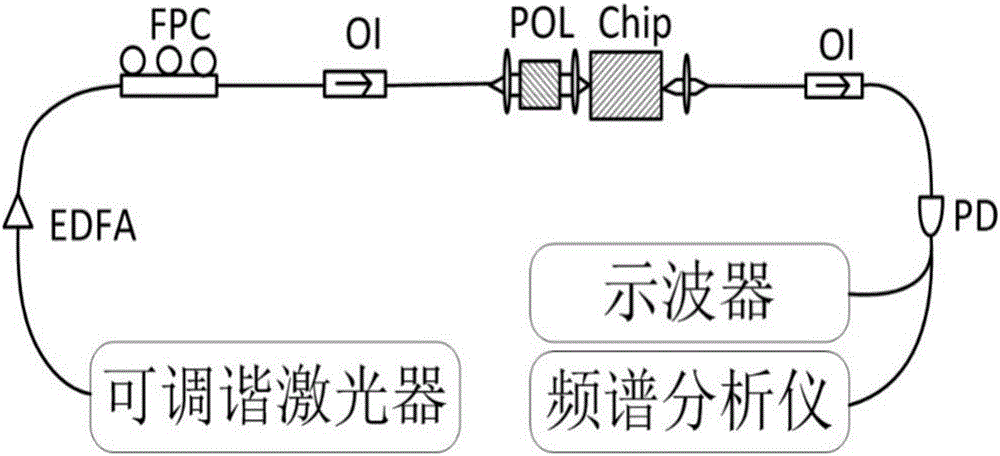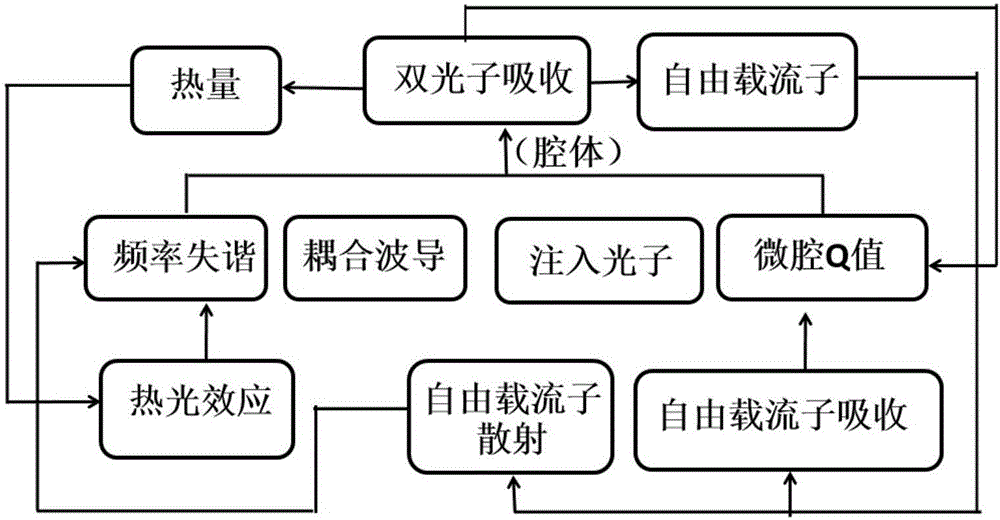Optical chaos generating device based on silicon photon microcavity
A technology of silicon photonics and microcavity, which is applied to the device for controlling the output parameters of lasers, the structure of optical resonators, lasers, etc., can solve the problems of high cost, inability to mass-produce, semiconductor lasers cannot be integrated, etc., and achieve low manufacturing cost , high local energy density, high quality factor effect
- Summary
- Abstract
- Description
- Claims
- Application Information
AI Technical Summary
Problems solved by technology
Method used
Image
Examples
specific Embodiment 1
[0018] attached image 3 It is the output result of the initial stage of oscillation in the silicon photonic microcavity when the wavelength of the injected light is 1573.6 nm. As can be seen from the figure, it can be seen from the figure that the fluctuation of the time series is basically at the background noise level, while the phase diagram trajectory is basically shrunk to one point, and there is a weak signal appearing around 120MHz in the spectrum diagram. This series of results shows that the silicon photonic microcavity is now in the initial stage of oscillation.
specific Embodiment 2
[0020] attached Figure 4 It is the self-pulsation in the silicon photonic microcavity when the wavelength of the injected light is 1573.8nm. As can be seen from the left figure, the time series has some spontaneous pulsations, which will suddenly deviate from the equilibrium point and then quickly collapse back to the equilibrium point. The phase diagram shows that the system oscillates around the equilibrium point most of the time. Occasional bursts return to equilibrium after approximately 2 periods of oscillation. Further spectrum measurement shows that the system has an oscillation peak of 120MHz, and a strong low-frequency oscillation appears near 0-40MHz. This low-frequency oscillation corresponds to the self-pulsation signal. This result shows that the silicon photonic microcavity is already transitioning to a more complex chaotic state.
specific Embodiment 3
[0022] attached Figure 5 It is the optical chaotic oscillation phenomenon in the microcavity when the wavelength of the injected light is 1575.1nm. First of all, some complex aperiodic oscillations appear in the time series of the system. These oscillating phase trajectories no longer repeat, but continuously extend and stretch around the center of the attractor. Further spectrum measurement shows that the test signal spectrum is continuously covered from the low frequency band to the cut-off point of 200MH. These time domain and frequency domain test results clearly illustrate the generation of optical chaos.
[0023] Obviously, the present invention is based on the optical chaos generating device of silicon photonic microcavity to produce chaos with silicon photonic microcavity device, so that it can be fully integrated in CMOS, the manufacturing cost is low, and it is suitable for large-scale mass production; and it has smaller mode volume and higher Quality factor, hig...
PUM
 Login to View More
Login to View More Abstract
Description
Claims
Application Information
 Login to View More
Login to View More - R&D
- Intellectual Property
- Life Sciences
- Materials
- Tech Scout
- Unparalleled Data Quality
- Higher Quality Content
- 60% Fewer Hallucinations
Browse by: Latest US Patents, China's latest patents, Technical Efficacy Thesaurus, Application Domain, Technology Topic, Popular Technical Reports.
© 2025 PatSnap. All rights reserved.Legal|Privacy policy|Modern Slavery Act Transparency Statement|Sitemap|About US| Contact US: help@patsnap.com



